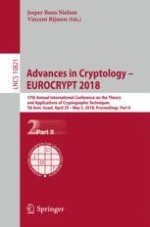2018 | OriginalPaper | Buchkapitel
Multi-Collision Resistant Hash Functions and Their Applications
verfasst von : Itay Berman, Akshay Degwekar, Ron D. Rothblum, Prashant Nalini Vasudevan
Erschienen in: Advances in Cryptology – EUROCRYPT 2018
Aktivieren Sie unsere intelligente Suche, um passende Fachinhalte oder Patente zu finden.
Wählen Sie Textabschnitte aus um mit Künstlicher Intelligenz passenden Patente zu finden. powered by
Markieren Sie Textabschnitte, um KI-gestützt weitere passende Inhalte zu finden. powered by
Abstract
-
The existence of \(\mathsf {MCRH}\) follows from the average case hardness of a variant of the Entropy Approximation problem. The goal in this problem (Goldreich, Sahai and Vadhan, CRYPTO ’99) is to distinguish circuits whose output distribution has high entropy from those having low entropy.
-
\(\mathsf {MCRH}\) imply the existence of constant-round statistically hiding (and computationally binding) commitment schemes. As a corollary, using a result of Haitner et al. (SICOMP, 2015), we obtain a blackbox separation of \(\mathsf {MCRH}\) from any one-way permutation.







